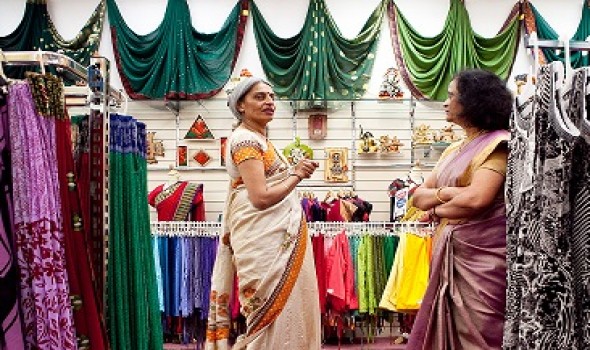‘Wow! How good is that!’
‘Wow! How good is that!’

By Daniel Nelson The first picture on the left as you enter 100 Images of Migration is of Lance Corporal Johnson Beharry, originally from Grenada, who won a Victoria Cross serving with the British army in Iraq. The message is clear: immigrants are prepared to perform deeds of incredible heroism and lay down their lives for this country. But Beharry is not a symbol: he’s a man doing his best in a difficult world (whose best happens to be better than most of us will ever achieve). In the same way, he is not an immigrant: that’s just a label for one particular aspect of his life. That goes for all the other individuals in this simple but absorbing exhibition at the Hackney Museum in east London, though for an unlucky few their immigration status is of crucial importance. For example, one of the 100 images is a British Overseas Citizen passport given to a Malaysian, Hendy, who was told it would enable him to live and work here. But it didn’t and doesn’t. The accountant is now effectively stateless and forced to work in a restaurant to make ends meet. Another of the images is of the bronze statue of the Kindertransport, the mission that rescued almost 10,000 predominantly Jewish children from Nazi Germany and nearby countries. One of them, Alf Dubs, became an MP and now sits in the House of Lords. In the text accompanying the statue (itself created by a former Kindertransport refugee, Frank Meister), he recalls … “a knapsack of uneaten food that my mother had packed for the journey, the midnight departure from Prague with my anxious mother standing near a German soldier with a swastika armband and the interminably long train journey sitting on hard wooden seats, the night boat to Harwich and then London and a new beginning.” Many of the refugees have inspirational stories to tell. Maurice Nwokeji, who survived the Biafra war in Nigeria, says: “I come from a background of war, starvation, hatred. I was taught to hate from the age of five. I hated all my life and I don’t any more. Wow! How good is that!” For him, Rastafarianism and a guitar did the trick. Lily Ebert tells of a small pendant, originally hidden in the heel of her mother’s shoe. At Auschwitz concentration camp, her mother asked her to swap shoes, before disappearing forever. When Lily’s shoes wore out she hid the pendant in her bread ration and when her sisters were transferred to an arms factory the pendant went with them. Amazingly, they all survived and Lily brought the pendant to London in 1967, wearing it every day. She believes it is the only gold to enter and leave the camp with its rightful owner. Some refugees are less lucky. Yasser was tortured in Sudan before escaping to Birmingham. He loves UK, but even though he has asylum status he is scared to call on the authorities such as the police or ambulance in case he is sent back to Sudan. Most of the photos and the small number of objects – such as sports writer Mihir Bose’s Panama hat – are “economic migrants”, who have come here in search of a better life. Their stories are touching and sometimes recall almost forgotten bits of British history, such as the 10,000 southern Italian men recruited in the 1950s to work in the brick fields around Luton and Bedford. They regularly took a truckload of supplies to a less well-organised community in Gillingham, delivering olive oil, pasta, coffee, garlic, aubergines, artichokes and parsley seeds – “the sort of stuff our local British shopkeepers called ‘nasty foreign muck’.” Also rescued from oblivion: the crest, designed in 1901, of the London council of Wandsworth includes tears on the shield “to represent the sufferings of the Huguenot refugees who settled on the river Wandle” in the 1700s. What chance today of British crests and flags incorporating refugees and migrants? The exhibition shows the bad (racist demos; a flat to let notice saying “No coloured”; a 1972 Leicester council advertisement in a Ugandan newspaper advising people of Asian origin not to head for the city; the fact that some of the early African arrivals were slaves) as well as the good (a loving tribute to a South Asian father who made a reality of the migrant’s dream of a better life). It also shows, in a small way, outward migration. There’s a wonderfully happy 1966 photo of 12 members of an Irish family emigrating to Canada, and Rodney Yates recalls how, “ostensibly a native of Papua New Guinea, having been born there, my uprooting was age 8 when along with my brother Ed we were ‘repatriated’ to a life we had never known.” As the exhibition introduction says, “Britain has not always welcomed people or made their lives easy. Many people coming here have had hard journeys and difficult transitions. Many find living here unacceptable and move on. But mostly Britain is and has been a refugee and a country of opportunity.” * The pictures are online at http://www.hackney.gov.uk/migration.htm + The exhibition is the first project of the http://www.migrationmuseum.org Migration Museum Project, “which aims to fill a gap by creating an exhilarating Migration Museum, an Ellis island for the UK, a gripping and moving tribute to the part that migrants have played in the making of Britain.” + http://www.guardian.co.uk/uk/2013/jun/11/100-images-of-migration * 100 Images of Migration is at the Hackney Museum, 1 Reading Lane, London E8, until 31 August. Info: [email protected]/ http://www.hackney.gov.uk/hackneymuseum This article first appeared on: http://oneworld.org/news Photograph by Kajal Nisha Patel, from the 100 Images of Migration Exhibition.


